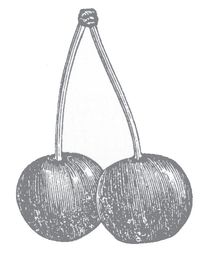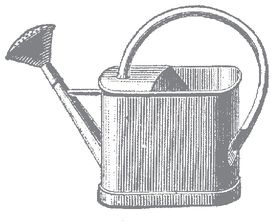Food Rules (9 page)
Authors: Michael Pollan


58
Do all your eating at a table.
No, a desk is not a table. If we eat while we’re working, or while watching TV or driving, we eat mindlessly—and as a result eat a lot more than we would if we were eating at a table, paying attention to what we’re doing. This phenomenon can be tested (and put to good use): Place a child in front of a television set and place a bowl of fresh vegetables in front of him or her. The child will eat everything in the bowl, often even vegetables he or she doesn’t ordinarily touch, without noticing what’s going on. Which suggests an exception to the rule: When eating somewhere other than at a table, stick to fruits and vegetables.

59
Try not to eat alone.
Americans are increasingly eating in solitude. Although there is some research to suggest that light eaters will eat more when they dine with others (perhaps because they spend more time at the table), for people prone to overeating, communal meals tend to limit consumption, if only because we’re less likely to stuff ourselves when others are watching. We also tend to eat more slowly, since there’s usually more going on at the table than ingestion. This is precisely why so much food marketing is designed to encourage us to eat in front of the TV or in the car: When we eat alone, we eat more. But regulating appetite is only part of the story: The shared meal elevates eating from a biological process of fueling the body to a ritual of family and community.

60
Treat treats as treats.
There is nothing wrong with special occasion foods, as long as every day is not a special occasion. This is another case where the outsourcing of our food preparation to corporations has gotten us into t rouble: It’s made formerly expensive or time-consuming foods—everything from fried chicken and french fries to pastries and ice cream—easy and readily accessible. Frying chicken is so much trouble that people didn’t use to make it unless they had guests coming over and a lot of time to prepare. The amount of work involved kept the frequency of indulgence in check. These special occasion foods offer some of the great pleasures of life, so we shouldn’t deprive ourselves of them, but the sense of occasion needs to be restored. One way is to start making these foods yourself; if you bake dessert yourself, you won’t go to that much trouble every day. Another is to limit your consumption of such foods to weekends or social occasions. Some people follow a so-called S policy: “no snacks, no seconds, no sweets—except on days that begin with the letter S.”

61
Leave something on your plate.
Many of us were told by our parents while growing up that we should always clean our plates—an instruction that in later life we have perhaps taken a little too much to heart. But there is an older and healthier tradition that holds it is more genteel
not
to finish every last morsel of food: “Leave something for Mr. Manners,” some children once were told, or, “Better to go to waste than to waist.” Practice
not
clean ing your plate; it will help you eat less in the short term and develop self-control in the long.
not
to finish every last morsel of food: “Leave something for Mr. Manners,” some children once were told, or, “Better to go to waste than to waist.” Practice
not
clean ing your plate; it will help you eat less in the short term and develop self-control in the long.

62
Plant a vegetable garden if you have the space, a window box if you don’t.
What does growing some of your own food have to do with repairing your relationship to food and eating? Everything. To take part in the intricate and endlessly interesting processes of providing for your sustenance is the surest way to escape the culture of fast food and the values implicit in it: that food should be fast, cheap, and easy; that food is a product of industry, not nature; that food is fuel rather than a form of communion with other people, and also with other species—with nature. On a more practical level, you will eat what your garden yields, which will be the freshest, most nutritious produce obtainable; you will get exercise growing it (and get outdoors and away from screens); you will save money (according to the N ational Gardening Association, a seventy-dollar investment in a vegetable garden will yield six hundred dollars’ worth of food); and you will be that much more likely to follow the next, all-important rule.
63
Cook.
In theory, it should make little difference to your health whether you cook for yourself or let someone else do the work. But unless you can afford to hire a private chef to prepare meals exactly to your specifications, letting other people cook for you means losing control over your eating life, the portions as much as the ingredients. Cooking for yourself is the only sure way to take back control of your diet from the food scientists and food processors, and to guarantee you’re eating real food and not edible foodlike substances, with their unhealthy oils, high-fructose corn syrup, and surfeit of salt. Not surprisingly, the decline in home cooking closely parallels the rise in obesity, and research suggests that people who cook are more likely to eat a more healthful diet.

64
Break the rules once in a while.
Obsessing over food rules is bad for your happiness, and probably for your health too. Our experience over the past few decades suggests that dieting and worrying too much about nutrition has made us no healthier or slimmer; cultivating a relaxed attitude toward food is important. There will be special o ccasions when you will want to throw these rules out the window. All will not be lost (especially if you don’t throw out number 60). What matters is not the special occasion but the everyday practice—the default habits that govern your eating on a typical day. “All things in m oderation,” it is often said, but we should never forget the wise addendum, sometimes attributed to Oscar Wilde: “Including moderation.”
Acknowledgments
I want to thank all the people who helped in the writing of this book, many of whom I don’t know by name, and many of whom don’t even know they’ve helped. But several I’m happy to be able to acknowledge by name. David Ludwig, MD, read the manuscript and made many valuable suggestions; he also caught several errors, though he shouldn’t be held responsible for any that remain. He has been an invaluable teacher on questions of nutrition. So has Daphne Miller, MD, who contributed several memorable rules drawn from her medical practice and extensive fieldwork on traditional diets around the world. I’ve also learned a lot about diet and health from my conversations with Marion Nestle, Walter Willett, and Joan Gussow, even though I’m sure each will find things to disagree with in these pages. Special thanks to Tara Parker-Pope at the
New York Times
for letting me solicit rules on her blog, and to her readers, whose overwhelming response enriched the project immeasurably. My old friend and colleague Michael Schwarz read the manuscript and improved it with his editing; thank you once again. Thanks again, too, to Amanda Urban and her crack team at ICM, and to the wonderful crew at Penguin, but especially to Ann Godoff, Lindsay Whalen, Holly Watson, and Rachel Burd. For her first-rate research and editing I’m grateful to Malia Wollan. Adrienne Davich also contributed valuable research and fact-checking. And finally, heartfelt thanks to Judith and Isaac, the best dinner companions anyone could wish for; your ideas and words (not to mention your cooking) always nourish me, and particularly nourished this book.
New York Times
for letting me solicit rules on her blog, and to her readers, whose overwhelming response enriched the project immeasurably. My old friend and colleague Michael Schwarz read the manuscript and improved it with his editing; thank you once again. Thanks again, too, to Amanda Urban and her crack team at ICM, and to the wonderful crew at Penguin, but especially to Ann Godoff, Lindsay Whalen, Holly Watson, and Rachel Burd. For her first-rate research and editing I’m grateful to Malia Wollan. Adrienne Davich also contributed valuable research and fact-checking. And finally, heartfelt thanks to Judith and Isaac, the best dinner companions anyone could wish for; your ideas and words (not to mention your cooking) always nourish me, and particularly nourished this book.
1
For a discussion of the research on the Western diet and its alternatives see my previous book,
In Defense of Food
(New York: Penguin Press, 2008). Much of the science behind the rules in this book can be found there.
In Defense of Food
(New York: Penguin Press, 2008). Much of the science behind the rules in this book can be found there.
2
The diet specified in this analysis is characterized by a low intake of transfats; a high ratio of polyunsaturated fats to saturated fats; a high whole-grain intake; two servings of fish a week; the recommended daily allowance of folic acid; and at least five grams of alcohol a day. The lifestyle changes include not smoking, maintaining a body mass index (BMI) below 25, and thirty minutes a day of exercise. As the author Walter Willett writes, “[T]he potential for disease prevention by modest dietary and lifestyle changes that are readily compatible with life in the 21st century is enormous.” “The Pursuit of Optimal Diets: A Progress Report,”
Nutritional Genomics: Discovering the Path to Personalized Nutrition,
eds. Jim Kaput and Raymond L. Rodriguez (New York: John Wiley & Sons, 2006).
Nutritional Genomics: Discovering the Path to Personalized Nutrition,
eds. Jim Kaput and Raymond L. Rodriguez (New York: John Wiley & Sons, 2006).
Other books
Everything Is Cinema: The Working Life of Jean-Luc Godard by Richard Brody
The Commander by CJ Williams
Veil of Shadows by Walker, Shiloh
Up in Honey's Room by Elmore Leonard
Blurring the Lines-nook by Roni Loren
The Starter Boyfriend by Tina Ferraro
Earth Child (Romance Novels of The Fae Realm) by Green, Rosemary
The Chosen Soul by Heather Killough-Walden
There But For The Grace by A. J. Downey, Jeffrey Cook
The Shaping of the Modern Middle East by Bernard Lewis
